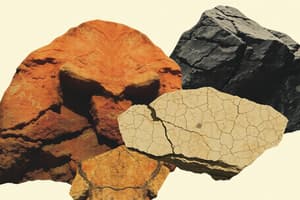Podcast
Questions and Answers
What are igneous rocks primarily formed from?
What are igneous rocks primarily formed from?
- The precipitation of minerals from water
- The accumulation of sediment
- The transformation of existing rock types
- The cooling and solidification of molten rock (correct)
Which type of sedimentary rock is formed from fragments of other rocks?
Which type of sedimentary rock is formed from fragments of other rocks?
- Organic
- Clastic (correct)
- Metamorphic
- Chemical
What properties are used to identify minerals?
What properties are used to identify minerals?
- Hardness, luster, color (correct)
- Chemical composition, temperature, size
- Density, texture, weight
- Color, size, shape
What process forms metamorphic rocks?
What process forms metamorphic rocks?
Which of the following is an example of an extrusive igneous rock?
Which of the following is an example of an extrusive igneous rock?
Flashcards are hidden until you start studying
Study Notes
Igneous Rocks
- Formed by cooling and solidification of molten rock (magma or lava).
- Intrusive (Plutonic): Develops beneath the Earth's surface; examples include granite.
- Extrusive (Volcanic): Occurs on the Earth's surface; examples include basalt.
Sedimentary Rocks
- Created from the accumulation and lithification of sediment.
- Clastic: Composed of fragments from other rocks; examples include sandstone.
- Chemical: Forms from mineral precipitation out of water; a common example is limestone.
- Organic: Includes organic material; a key example is coal.
Metamorphic Rocks
- Result from the transformation of existing rocks through heat, pressure, and chemical processes.
- Example: Marble forms from the metamorphosis of limestone.
Minerals
- Defined by being naturally occurring, inorganic, solid substances with a definite chemical composition and ordered internal structure.
- Properties include:
- Hardness: Measured using the Mohs scale, which ranks minerals from 1 (talc) to 10 (diamond).
- Luster: The way light interacts with the surface of a mineral.
- Color: The apparent hue of the mineral.
- Streak: The color of the mineral in powdered form.
- Cleavage: The tendency of a mineral to break along flat planes.
- Fracture: The way a mineral breaks other than along cleavage planes.
- Specific Gravity: The ratio of a mineral's weight to the weight of an equal volume of water.
Studying That Suits You
Use AI to generate personalized quizzes and flashcards to suit your learning preferences.




